|
"When I was
thirteen, I had a voice from God to help me to govern myself. The first time, I was
terrified. The voice came to me about noon: it was summer, and I was in my father’s
garden….I saw it many times before I knew it was Saint Michael….He was not
alone, but duly attended by heavenly angels….He told me Saint Catherine and Saint
Margaret would come to me, and I must follow their counsel; that they were appointed to
guide and counsel me in what I had to do, and that I must believe what they would tell me,
for it was at our Lord’s command." In Her Own
Words, p. 5-6
Saint Joan continually professed counsel and protection
from three voices guiding her in the mission to free her country from
occupation: Saint Michael the Archangel, Saint Catherine of Alexandria and
Saint Margaret, sometimes called Marina. Although not often mentioned, Joan
also reported being visited by Saint Gabriel.
Archangel Michael was the first to appear
to young Joan when she was in her thirteenth year. He told Joan that Saint Catherine and
Saint Margaret would soon follow. She was to obey their instruction. Whereas
Archangel Michael was brilliant and bold, her descriptions of Saint
Catherine and Saint Margaret were of gentle comforters.
The female saints guided her through the
next four years of her childhood, instructing her on proper ways to govern
herself. They primed her, instilling virtues she would need for a greater
mission, which she did not fully comprehend at the time.
When Joan turned seventeen, the guidance
from her voices changed. Saint Michael visited more often, outlining a plan
which involved the young girl liberating her country. Joan's response showed
her attempt to make sense of what she was being told to do: "And I
answered the Voice that I was a poor girl who knew nothing of riding and
warfare." In Her Own Words, p. 7.
Her response is not unlike the Mother Mary's logical conclusion when she was
told she was to be with child: "How can this be, as I know not a man." Joan
eventually came to this understanding: "Since God had commanded me to go,
I must do it. And since God had commanded it, had I had a hundred fathers
and a hundred mothers, and had I been a king's daughter, I would have gone."
In Her Own Words, p. 11
Saint Michael, Saint Catherine and
Saint Margaret had won her devotion and her confidence. It was in them she
put her complete faith, moving always in the direction they led. Her
guardians not only provided counsel, but forewarned of mishaps, personal
injury and eventually her own capture and death.
It's no surprise these three guardians
became Joan's patron saints. She shared many similarities with Saint
Catherine, and Saint Margaret was an ever-present visual reminder to young
Joan in the chapel at Domremy. It was here, in her hometown that Joan prayed
before the statue of Saint Margaret, which still stands to this day. Like
Joan of Arc, both female saints before her were similarly persecuted for
refusing to deny their faith and were virgin martyrs. Although Joan denied
her faith when brought before the stake and threatened with being burned
alive, she recanted, citing that what she said she said for fear of the
fire.
The connection to Saint Michael is just
as obvious. He has been around since the time of the Old Testament in which
he was known for interceding for the human race. Archangel Michael, whose name means "One
who is like God," was the protector of France, and Joan certainly would have
known this. Stories about him, which Joan would have heard, figure him
predominantly as champion and leader of faithful angels in their struggle
against evil.
There are two feast days honoring Saint
Michael: September 29, which honors the dedication of the Church of St. Michael in
Rome during the sixth century, and May 8, which commemorates the day of his
apparition in Italy. Interestingly, on May 8, 1429, after only
three days of her first battle, Joan of Arc realized her first military
victory by liberating the city of
Orléans from a
successful seven month siege by the English. Saint Michael's intercession
would continue as her military campaign progressed.
    
Archangel Michael
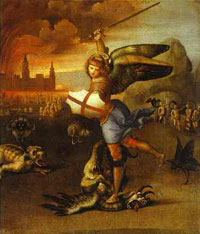 Patron of soldiers and law enforcement Patron of soldiers and law enforcement
Feast Day: May 8 and September 29
Saint Michael was the patron saint of the
royal house of France during Joan's life, so it makes sense that she
naturally held an affinity for him. He commanded her to go to the aid of
France and eventually appeared to her as a war counselor. Saint Michael is
typically depicted in armor with wings outstretched and sword or lance
drawn, ready to pierce the serpent being restrained under foot. In many
medieval paintings, he bears a shield with a red cross that represents
"truth". Michael is the champion of woman, specifically protecting the
Mother Mary and her offspring. He is referred to as the prince of angels and
is first in the nine angelic orders.
"Above all, Saint Michael told me that
I must be a good child, and that God would help me. He taught me to behave
rightly and go often to church.... He told me the pitiful state of the
Kingdom of France. And he told me that I must go to succor the King of
France." In Her Own Words, p. 6.
Saint Catherine of Alexandria
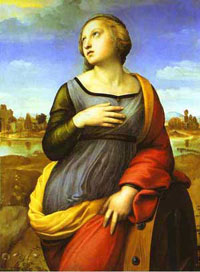 Patroness
of philosophers and teachers Patroness
of philosophers and teachers
Feast Day: November 25
"Saint Catherine and Saint Margaret
had rich crowns on their heads. They spoke well and fairly, and their voices
are beautiful--sweet and soft. The name by which they often named me was
Jehanne the Maid, Child of God. They told me that my King would be restored
to his Kingdom, despite his enemies. They promised to lead me to
Paradise." In Her Own Words, p. 7
Saint Catherine, along with Saint
Margaret, was sent to guide Joan of arc on her mission, giving her constant
counsel, guidance and protection. Saint Catherine was a virgin martyr born
of a noble family in Alexandria. She converted to Christianity through a
vision of the Mother Mary and publicly denounced her Emperor Maxentius for
persecuting Christians. Maxentius offered Catherine, age 18, a royal
marriage if she would but deny her faith. However, like Joan, Saint
Catherine had taken a vow of chastity and so promptly refused his offer. She
was just as promptly delivered to prison. The young girl's boldness
interested the Emperor so he called numerous scholars to use their skills in
reason and logic to outwit the girl. Catherine proved to be admirable,
gracious and eloquently convincing in all lines of questioning, actually
converting several of her adversaries.
Saint Catherine's demeanor was not unlike
Joan of Arc's, who, when subjected to three weeks of questioning by learned
scholars at Chinon and Poitiers, was said to carry herself with dignity,
speaking with clarity of reason that often outsmarted and influenced highly
learned men. When this comparison is noted, Saint Catherine fulfills her
role by guiding Joan's words and actions. When Joan of Arc successfully
persuaded the theologians at Poitiers in March, 1429, that "...in her has
been found nothing evil; only good, humility, virginity, devotion, honesty,
simplicity." townspeople began referring to the Maid as "another Saint
Catherine brought down to earth."
Saint Catherine reported an angel of the
Lord at her side during all questioning, who assured her to stand firm that
she would not be defeated. Perhaps she decided to repay the favor be
attending to the young Joan of Arc who shared a similar torture,
imprisonment, trial and martyrdom.
While in captivity, Catherine's influence
caused Maxentius' wife and two hundred of his soldiers to convert. The
Emperor had the newly converted put to death and condemned Catherine to the
same fate. She was tortured by being placed on a spiked wheel that is said
to have shattered. Her death unsuccessful, Maxentius had her beheaded. Saint
Catherine is often depicted wearing a crown and holding her torture device,
a wooden wheel and the sword used to behead her. Saint Catherine boldly
confronted evil in the name of truth and justice, very similar to Joan of
Arc.
At the moments of Catherine's death,
legend tells us angels lifted her body, carrying it to Mount Sinai, giving
her an honorable burial. A monk from Rouen, the place of Saint Joan's
burning, is said to have journeyed to Mount Sinai, staying there for seven
years, in service to Saint Catherine. Later, a similar monk from Rouen paid
tribute to Saint Joan by retrieving a cross at the Maid's request and
holding it before her during her last moments tied to the stake. Saint
Catherine is known as one of the Fourteen Holy Helpers, as is Saint
Margaret.
Saint Margaret
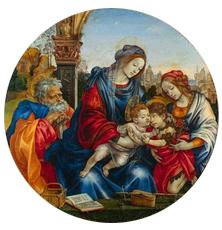 Patroness
of pregnant women Patroness
of pregnant women
Feast Day: July 20
Margaret is sometimes called Marina. She is believed to
have been the daughter of a pagan priest, converting against family wishes
to Christianity. Saint Margaret was a shepherdess who attracted the interest
of a local prefect. Margaret refused his marriage proposal, for like
Catherine and Joan, she had consecrated herself to God. The prefect Olybrius
had her imprisoned and tortured for her rejection. When threats of
punishment had no effect on Margaret, he had her brought before a public
trial. She was threatened with burning but refused to renounce God. She was
eventually beheaded. Saint Margaret is often depicted standing over the
dragon, sent by Satan to tempt her.
Joan of Arc shared a similar fate with the guardians who
offered their counsel, especially Saint Catherine and Saint Margaret. In the
trial transcripts Joan responds candidly to her
accusers, often times with frustrated exasperation:
"Did they have hair?"
"It is a comfort to know that they have."
"Was Saint Michael naked?"
"Do you think God has nothing with which to clothe
him?"
"Did Saint Margaret speak English?"
"Why would she speak in English when she is not on
the English side?"
In Her Own Words, p. 103-105
It is impossible to understand Joan of Arc's motivation
and steadfast moral values without first understanding the voices which she
attributes every good thing she accomplished. Her deep love, faith and
reverence for her helpers were best apparent in her actions. Attempting to
express the Voices' profound influence on her life:
"There is no day that I do
not hear the voice. And indeed I need it. I have never asked it for any
other reward than, in the end, the salvation of my soul."
"I saw them with the eyes of
my body as well as I see you. And when they left me, I wept, and I wished
that they might have taken me with them. And I kissed the ground where they
stood, to do them reverence." In Her Own Words, p. 94,
6
|
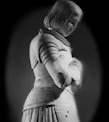

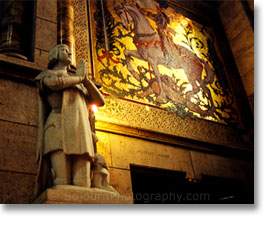
 Patron of soldiers and law enforcement
Patron of soldiers and law enforcement Patroness
of philosophers and teachers
Patroness
of philosophers and teachers Patroness
of pregnant women
Patroness
of pregnant women